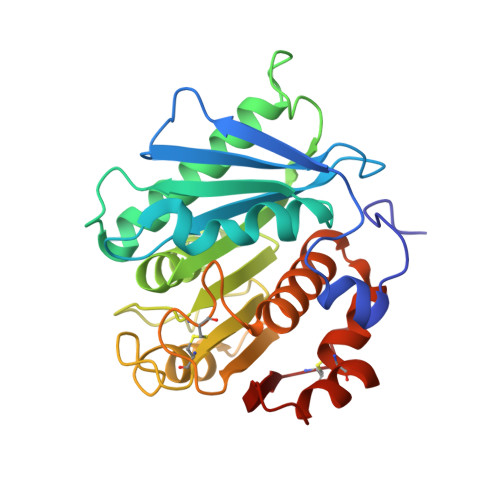Implications for the PET decomposition mechanism through similarity and dissimilarity between PETases from Rhizobacter gummiphilus and Ideonella sakaiensis.
Sagong, H.Y., Son, H.F., Seo, H., Hong, H., Lee, D., Kim, K.J.(2021) J Hazard Mater 416: 126075-126075
- PubMed: 34492896
- DOI: https://doi.org/10.1016/j.jhazmat.2021.126075
- Primary Citation of Related Structures:
7DZT, 7DZU, 7DZV - PubMed Abstract:
The development of a superb polyethylene terephthalate (PET) hydrolyzing enzyme requires an accurate understanding of the PET decomposition mechanism. However, studies on PET degrading enzymes, including the PET hydrolase from Ideonella sakaiensis (IsPETase), have not provided sufficient knowledge of the molecular mechanisms for the hardly accessible substrate. Here, we report a novel PET hydrolase from Rhizobacter gummiphilus (RgPETase), which has a hydrolyzing activity similar to IsPETase toward microcrystalline PET but distinct behavior toward low crystallinity PET film. Structural analysis of RgPETase reveals that the enzyme shares the key structural features of IsPETase for high PET hydrolysis activity but has distinguished structures at the surface-exposed regions. RgPETase shows a unique conformation of the wobbling tryptophan containing loop (WW-loop) and change of the electrostatic surface charge on the loop dramatically affects the PET-degrading activity. We further show that effect of the electrostatic surface charge to the activity varies depending on locations. This work provides valuable information underlying the uncovered PET decomposition mechanism.
Organizational Affiliation:
School of Life Sciences, BK21 FOUR KNU Creative BioResearch Group, Kyungpook National University, Daegu 41566, Republic of Korea; KNU Institute for Microorganisms, Kyungpook National University, Daegu 41566, Republic of Korea.














